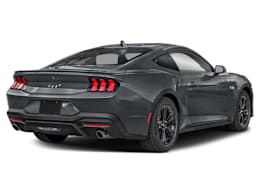The redesigned, seventh-generation Mustang retains this American automotive icon’s legendary power, sound, and swagger, but with modern connectivity and active safety features. The Mustang has long been a special breed, mixing brutish performance, style, and nostalgia. The new car builds on that to create a muscle car with a freshened appearance and incrementally increased horsepower.
It’s the visceral experience that distinguishes the Mustang, in an era where near-silent electric cars, SUVs, and trucks can match or beat its acceleration. But those EVs don’t have the rumble, throaty roar, or belching hellfire that a V8 can deliver.
For anyone who has ever fantasized about owning a Mustang, now may be the moment to “pony up,” as this could well be the final version with a V8 engine.
But before you cinch up your saddle, realize that the Mustang doesn’t come without compromises. It feels heavy and a bit clumsy compared to most sporty cars when pushed on a twisty road. The near-elimination of physical knobs and buttons results in an unintuitive controls layout, particularly affecting the climate system. And, as with most low-slung two-door sports coupes, it takes some athleticism to get in and out of the Mustang.
It’s the 480-horsepower, 5.0-liter V8 in our tested GT model that really “makes” this Mustang. It thrills with a throaty, intoxicating roar, strong low-end torque, and high-revving horsepower. We also love the precise, easy-shifting six-speed manual transmission and novice-friendly clutch take-up. (You can also get the Mustang GT with a 10-speed automatic transmission.) The fact that it rips from 0 to 60 mph in just 4.6 seconds is almost beside the point.
The Mustang GT isn’t a guilt-free reward, mind you. We measured just 20 mpg overall on regular fuel, although at least that’s a 1-mpg improvement over the previous generation. The Mustang’s standard engine is a 315-hp, 2.3-liter turbocharged four-cylinder that gets better fuel economy, but comes only with a 10-speed automatic and lacks the satisfying V8 sound and thrust.
Handling is competent, but you feel the Mustang’s weight through turns. Plus, there’s a long and wide hood to look out over, all of which makes it feel awkward through the twisty bits compared to more svelte sporty cars such as the BMW 230i Coupe, Nissan Z, Subaru BRZ, or Toyota Supra. It doesn’t help that the vague steering telegraphs little to the driver about tire grip. (Our car didn’t have the “GT Performance Package” with its stiffer suspension.) Still, it maintained a balanced and playful character when pushed hard around our twisty road course, without being too intimidating.
The ride is composed and fairly absorbent for a sporty car, making the Mustang a viable everyday vehicle—which can’t be said for many of its breed. Cabin noise levels are high compared to most cars, but more hushed than many sports cars. But if you don’t appreciate the sounds of a throbbing V8, the engine noise will likely become tedious on the highway. That’s why it’s a good reason to get the optional “Active Valve Exhaust,” which can change the sound from mild to wild with the push of a button.
The interior presentation is respectable with padded window sills, a soft-touch upper dashboard, some exposed stitching, and a few chrome bits. But there’s also lots of hard-plastic trim and a few rough edges here and there, which aren’t befitting of our test car’s $55,000-plus price.
The Mustang has ample front headroom and the driver has a good view of the gauges through the steering wheel. The front seats are comfortable but they don’t offer the kind of lateral support you’ll want for driving spiritedly through corners. Squeezing into the tight rear seat is a challenge, especially since neither of the front seats power-slide forward automatically when you tilt the seatback—a feature found in some other coupes. Once back there, foot room is surprisingly decent and there’s good under-leg support, but a lack of headroom means most adults simply won’t fit. It’s best for kids, or super-short trips only.
The cockpit centers around a digital driver’s instrument panel and infotainment screen, replacing the traditional dual-cowl design from Mustangs of yore. There are very few physical buttons, so even basic climate-control functions—like changing the fan speed or airflow mode—require rooting around in the center touchscreen’s menus. We’d much prefer if the climate controls were all physical knobs and buttons, which are typically easier to use while driving. There are multiple driving modes to choose from, and various ways to do so—by going through the touchscreen, pressing buttons on the steering wheel, or with a button on the center stack. While choices are typically a good thing, in this case it actually makes interacting with the car more confusing.
We’re happy to report that the Mustang comes standard with a plethora of active safety and driver assistance features, including automatic emergency braking with pedestrian and cyclist detection, automatic emergency braking that operates at highway speeds, blind spot warning, rear cross traffic warning, reverse automatic emergency braking, lane departure warning, lane keeping assistance, and automatic high beams. Adaptive cruise control and lane centering assistance are available.


























